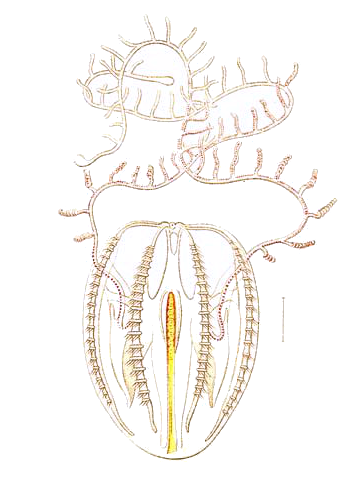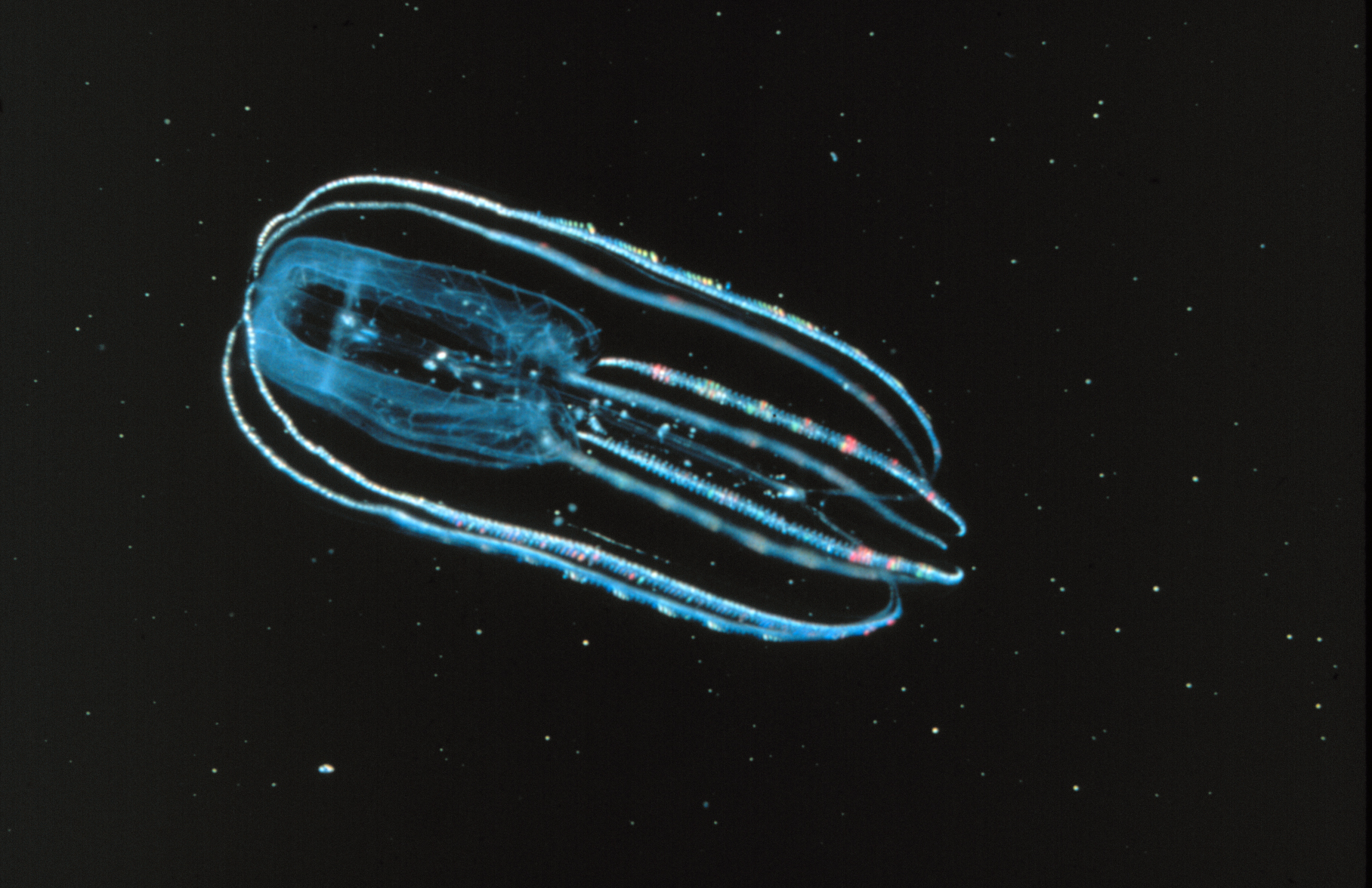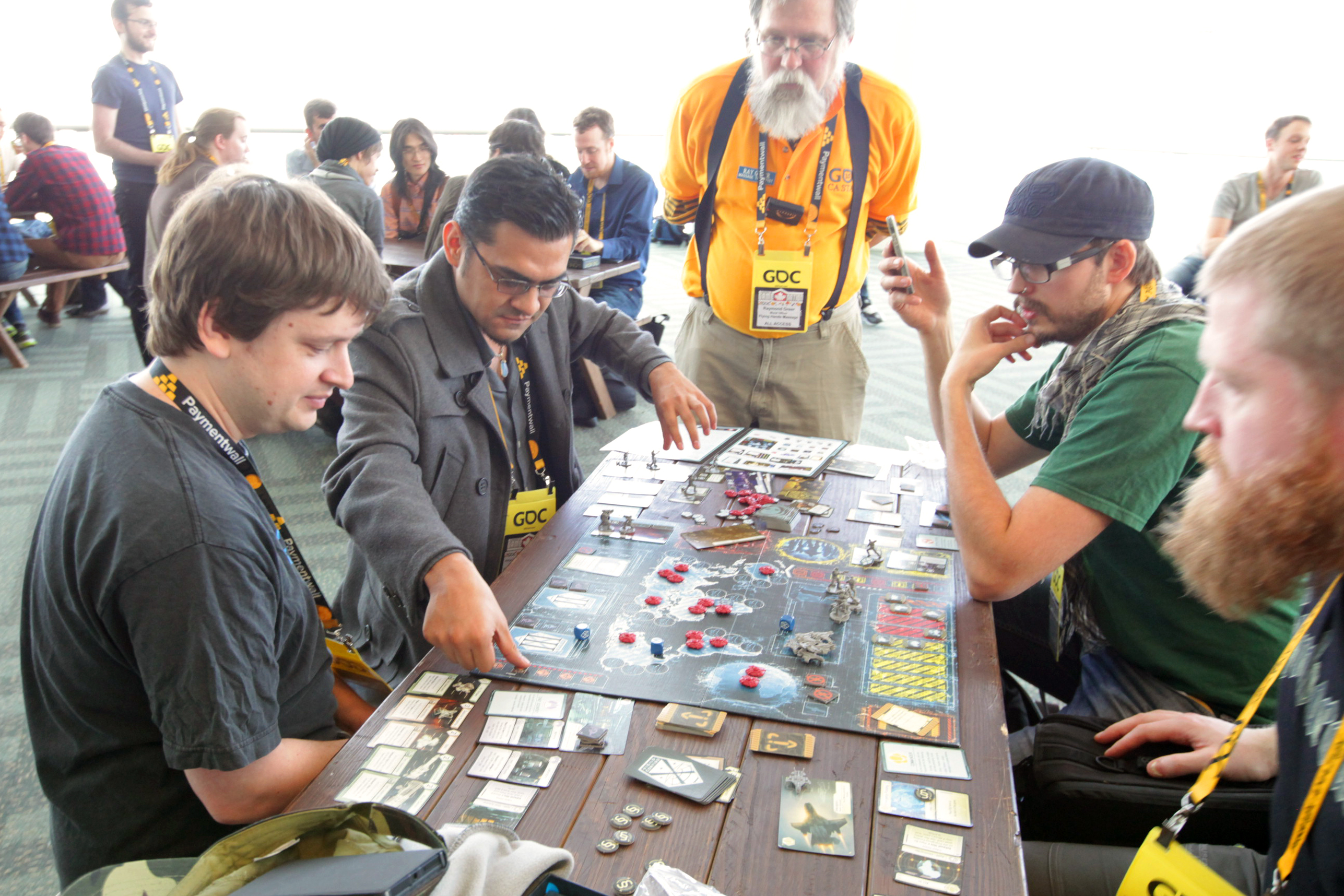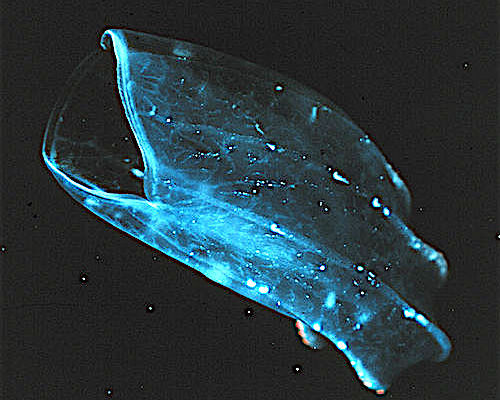|
Euplokamididae
''Euplokamis'' is a genus of ctenophores, or comb jellies, belonging to the monotypic family Euplokamididae. Despite living for hundreds of millions of years in marine environments, there is minimal research regarding ''Euplokamis'', primarily due to their body structure. Research on the evolution of the basic body structures of diploblastic metazoans revealed that there are four major phyla, including the Ctenophores. Although the morphology of ''Euplokamis'' often resembles the medusa stage of Cnidarians, their eight rows of combs are one distinguishing feature that led to the official classification of Ctenophores. After being originally described by Chun (1879), the family '' Euplokamididae'' was expanded by Mills (1987) due to the discovery of a new species, '' Euplokamis dunlapae''. Further research indicated that ''Euplokamis'' should be identified from Mertensiidae due to the rows of combs and some compression. They may also be distinguished from the genus ''Pleurobrachia ... [...More Info...] [...Related Items...] OR: [Wikipedia] [Google] [Baidu] |
Euplokamidae
''Euplokamis'' is a genus of ctenophores, or comb jellies, belonging to the monotypic family Euplokamidae, Euplokamididae. Despite living for hundreds of millions of years in marine environments, there is minimal research regarding ''Euplokamis'', primarily due to their body structure. Research on the evolution of the basic body structures of diploblastic metazoans revealed that there are four major phyla, including the Ctenophores. Although the morphology of ''Euplokamis'' often resembles the Medusae, medusa stage of Cnidarians, their eight rows of combs are one distinguishing feature that led to the official classification of Ctenophores. After being originally described by Chun (1879), the family ''Euplokamidae, Euplokamididae'' was expanded by Mills (1987) due to the discovery of a new species, ''Euplokamis dunlapae''. Further research indicated that ''Euplokamis'' should be identified from Mertensiidae due to the rows of combs and some compression. They may also be distinguish ... [...More Info...] [...Related Items...] OR: [Wikipedia] [Google] [Baidu] |
Ctenophore
Ctenophora (; ctenophore ; ) comprise a phylum of marine invertebrates, commonly known as comb jellies, that inhabit sea waters worldwide. They are notable for the groups of cilia they use for swimming (commonly referred to as "combs"), and they are the largest animals to swim with the help of cilia. Depending on the species, adult ctenophores range from a few millimeters to in size. Only 100 to 150 species have been validated, and possibly another 25 have not been fully described and named. The textbook examples are cydippids with egg-shaped bodies and a pair of retractable tentacles fringed with tentilla ("little tentacles") that are covered with colloblasts, sticky cells that capture prey. Their bodies consist of a mass of jelly, with a layer two cells thick on the outside, and another lining the internal cavity. The phylum has a wide range of body forms, including the egg-shaped cydippids with retractable tentacles that capture prey, the flat generally combless pl ... [...More Info...] [...Related Items...] OR: [Wikipedia] [Google] [Baidu] |
Ctenophora
Ctenophora (; ctenophore ; ) comprise a phylum of marine invertebrates, commonly known as comb jellies, that inhabit sea waters worldwide. They are notable for the groups of cilia they use for swimming (commonly referred to as "combs"), and they are the largest animals to swim with the help of cilia. Depending on the species, adult ctenophores range from a few millimeters to in size. Only 100 to 150 species have been validated, and possibly another 25 have not been fully described and named. The textbook examples are cydippids with egg-shaped bodies and a pair of retractable tentacles fringed with tentilla ("little tentacles") that are covered with colloblasts, sticky cells that capture prey. Their bodies consist of a mass of jelly, with a layer two cells thick on the outside, and another lining the internal cavity. The phylum has a wide range of body forms, including the egg-shaped cydippids with retractable tentacles that capture prey, the flat generally combless platyc ... [...More Info...] [...Related Items...] OR: [Wikipedia] [Google] [Baidu] |
Cydippida
Cydippida is an order of comb jellies. They are distinguished from other comb jellies by their spherical or oval bodies, and the fact their tentacles are branched, and can be retracted into pouches on either side of the pharynx. The order is not monophyletic, that is, more than one common ancestor is believed to exist. Anatomy Cydippids have bodies that are more or less rounded, sometimes nearly spherical and other times more cylindrical or egg-shaped; the common coastal "sea gooseberry," ''Pleurobrachia'', has an egg-shaped body with the mouth at the narrow end. From opposite sides of the body extends a pair of long, slender tentacles, each housed in a sheath into which it can be withdrawn. Some species of cydippids have bodies that are flattened to various extents, so that they are wider in the plane of the tentacles. The tentacles are typically fringed with tentilla ("little tentacles"), although a few genera have simple tentacles without these side-branches. The tentacles a ... [...More Info...] [...Related Items...] OR: [Wikipedia] [Google] [Baidu] |
Lobata
Lobata is an order of Ctenophora in the class Tentaculata with smaller tentacles than other ctenophores, and distinctive flattened lobes extending outwards from their bodies. They grow up to about long. Anatomy The lobates have a pair of lobes, which are muscular, cuplike extensions of the body that project beyond the mouth. Their inconspicuous tentacles originate from the corners of the mouth, running in convoluted grooves and spreading out over the inner surface of the lobes (rather than trailing far behind, as in the Cydippida). Between the lobes on either side of the mouth, many species of lobates have four auricles, gelatinous projections edged with cilia that produce water currents that help direct microscopic prey toward the mouth. This combination of structures enables lobates to feed continuously on suspended planktonic prey. Lobates have eight comb-rows, originating at the aboral pole and usually not extending beyond the body to the lobes; in species with (four) au ... [...More Info...] [...Related Items...] OR: [Wikipedia] [Google] [Baidu] |
Tentaculat
''XCOM'' (originally called ''X-COM'') is a science fiction video game franchise featuring an elite international organization tasked with countering alien invasions of Earth. The series began with the strategy video game '' X-COM: UFO Defense'' created by Julian Gollop's Mythos Games and MicroProse in 1994. The original lineup by MicroProse included six published and at least two canceled games, as well as two novels. The ''X-COM'' series, in particular its original entry, achieved a sizable cult following and has influenced many other video games; including the creation of a number of clones, spiritual successors, and unofficial remakes. A reboot series was published by 2K Games, beginning with the strategy video game '' XCOM: Enemy Unknown'', developed by Firaxis Games and released in 2012 to critical and commercial success. It was followed by the prequel '' The Bureau: XCOM Declassified'' and the sequels ''XCOM 2'' and '' XCOM: Chimera Squad''. Games Original ''X-COM ... [...More Info...] [...Related Items...] OR: [Wikipedia] [Google] [Baidu] |
Nuda
Beroidae is a family of ctenophores or comb jellies more commonly referred to as the beroids. It is the only family within the monotypic order Beroida and the class Nuda. They are distinguished from other comb jellies by the complete absence of tentacles, in both juvenile and adult stages. Species of the family Beroidae are found in all the world's oceans and seas and are free-swimmers that form part of the plankton. Anatomy Some members of the diverse genus ''Beroe'' may occasionally attain a length of up to , though most species and individuals are less than about 10 cm; '' Neis cordigera'' is among the largest species in the class, often exceeding in length. The body is melon or cone-shaped with a wide mouth and pharynx and a capacious gastrovascular cavity. Many meridional canals branch off this and form a network of diverticulae in the mesogloea. There are no tentacles but there are a row of branched papillae, forming a figure of eight around the aboral tip. The sack ... [...More Info...] [...Related Items...] OR: [Wikipedia] [Google] [Baidu] |
Tentaculata
Tentaculata is a class of comb jellies. The common feature of this class is a pair of long, feathery, contractile tentacles, which can be retracted into specialised ciliated sheaths. In some species, the primary tentacles are reduced and they have smaller, secondary tentacles. The tentacles have colloblasts, which are sticky-tipped cells that trap small prey. Body size and shape varies widely. The group includes the small, oval sea gooseberries found on both Atlantic and Pacific coasts. The more flattened species of the genus ''Mnemiopsis'', about long, are common on the upper Atlantic coast; it has a large mouth and mainly feeds on larval molluscs and copepods. This species is brilliantly luminescent. The similar, but larger, genus '' Leucothea'' is abundant on the Pacific coast. Venus girdle The Venus girdle (''Cestum veneris'') is a comb jelly in the family Cestidae. It is the only member of its genus, ''Cestum''. Description Venus girdles resemble transparent ri ... [...More Info...] [...Related Items...] OR: [Wikipedia] [Google] [Baidu] |
Carl Chun
Carl Chun (1 October 1852 – 11 April 1914) was a German marine biologist. Chun was born in Höchst, today a part of Frankfurt, and studied zoology at the University of Leipzig, where from 1878 to 1883 he was privat-docent of zoology and an assistant to Rudolf Leuckart. After professorial posts in Königsberg (1883–1891) and Breslau (1891–1898), he returned to Leipzig as a professor of zoology.UNI Leipzig Professorenkatalog (biographical sketch) In 1888, Chun described seasonal vertical migration (SVM) which has a periodicity of ca. 1 year. Chun examined depth-stratified net samples from the |
Cestida
Cestidae is a family of comb jellies. It is the only family in the monotypic order Cestida. Unlike other comb jellies, the body of cestids is greatly flattened, and drawn out into a long ribbon-like shape. The two tentacles are greatly shortened, and two of the four ciliated comb rows are reduced. The unusual body form allows the animals to swim by means of muscular undulation, as well as by using their cilia. The largest species, belonging to the genus ''Cestum'', can reach in length. Classification The order Cestida has one family, Cestidae, which contains two genera: '' Cestum'' and ''Velamen''. Each genus contains one species In biology, a species is the basic unit of classification and a taxonomic rank of an organism, as well as a unit of biodiversity. A species is often defined as the largest group of organisms in which any two individuals of the appropriate s .... * '' Cestum veneris'' Lesueur, 1813 * '' Velamen parallelum'' (Fol, 1869) References T ... [...More Info...] [...Related Items...] OR: [Wikipedia] [Google] [Baidu] |
Genus
Genus ( plural genera ) is a taxonomic rank used in the biological classification of living and fossil organisms as well as viruses. In the hierarchy of biological classification, genus comes above species and below family. In binomial nomenclature, the genus name forms the first part of the binomial species name for each species within the genus. :E.g. '' Panthera leo'' (lion) and '' Panthera onca'' (jaguar) are two species within the genus '' Panthera''. ''Panthera'' is a genus within the family Felidae. The composition of a genus is determined by taxonomists. The standards for genus classification are not strictly codified, so different authorities often produce different classifications for genera. There are some general practices used, however, including the idea that a newly defined genus should fulfill these three criteria to be descriptively useful: # monophyly – all descendants of an ancestral taxon are grouped together (i.e. phylogenetic analysis should cl ... [...More Info...] [...Related Items...] OR: [Wikipedia] [Google] [Baidu] |






